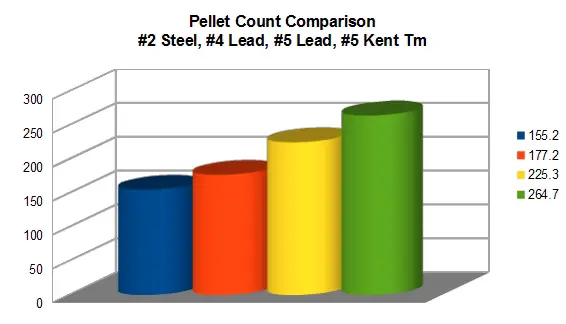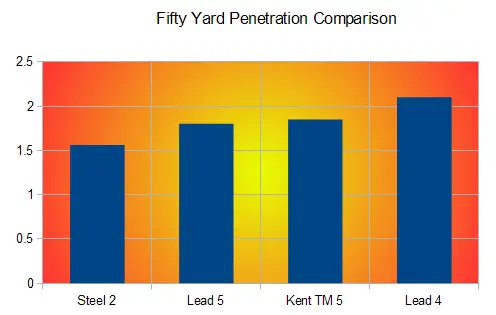


The 50 Yard Pheasant Load


Pattern percentage is of course a percentage of pellets you start with. I've made this chart to show the contrast between the 1-1/4 oz. #2 steel, 1-5/16 oz. 20 gauge #4 lead, 1-5/16 oz. 20 gauge #5 lead, and 1-1/2 oz. of Kent Tungsten-Matrix #5 pellet counts.
By the numbers, 1-1/4 oz. of steel #2 at 1400 fps yields 1.56 inches of gel penetration with 10.41 inches or wind drift assuming a 10 mph crosswind. It is about a 155 pellet load. This is a consideration as pattern efficiency expressed in percentage can only be a percentage of 155 pellets. This is a 12 gauge-only load.
The grex-buffered 20 gauge 1-5/16 oz #5 lead Winchester 20 gauge load, a 1200 fps load, offers 1.8 inches of gel penetration at 50 yards, 9.13 inches of wind drift, and is about a 225 pellet load. The same load in #4 shot reduces the pellet count to about 176 pellets, but gives better penetration at 2.1 inches and slightly less wind drift at 8.46 inches. If you want actual advantage in a 12 gauge pheasant no-tox load, the Kent Tungsten-Matrix 1-1/2 oz. #5 12 gauge load gets you there, as you can see by the comparison tables above.

In terms of gel penetration, the lower initial velocity #5 lead and #4 lead twenty gauge loads handily exceed the faster #2 steel at 50 yards. The trade-offs are for you to decide. Penetration is the best barometer of lethality. Note that the highest energy pellet, #2 steel at 3.51 ft./lbs, has by far the worst penetration of the group. That should convince you that the notions of kinetic energy and lethality are not always compatible.
Copyright 2012 by Randy Wakeman. All Rights Reserved.

Custom Search



